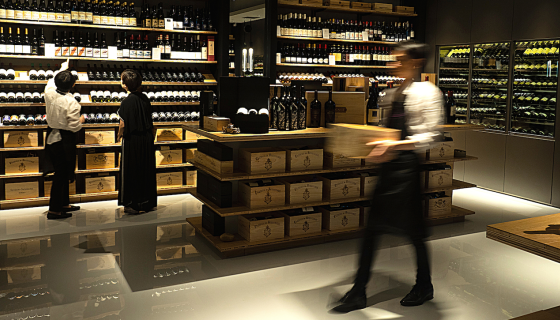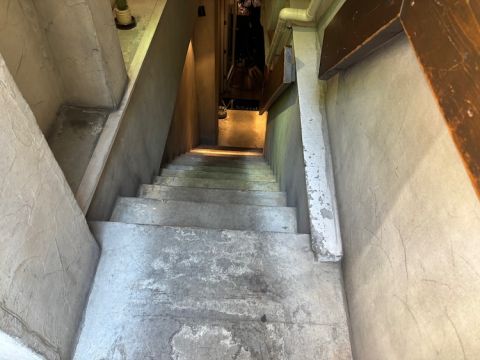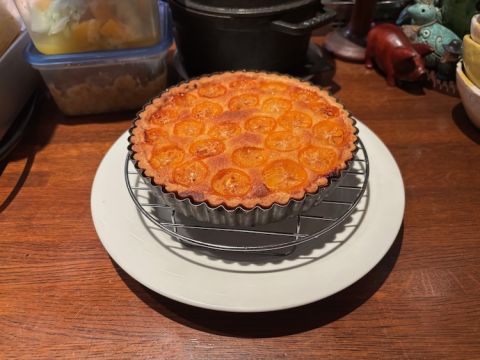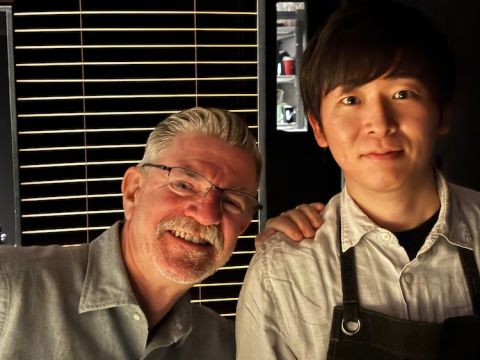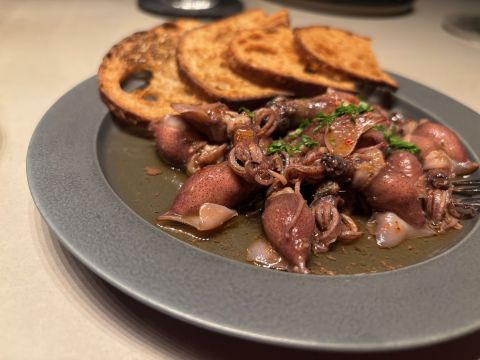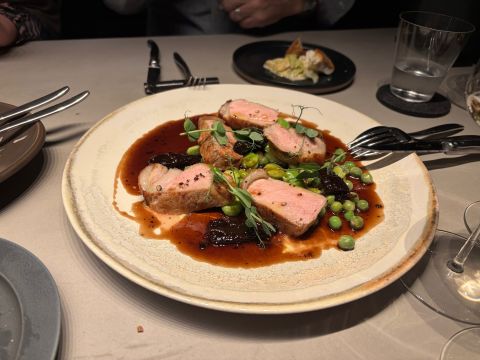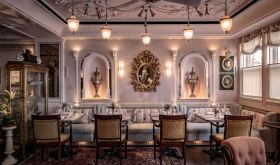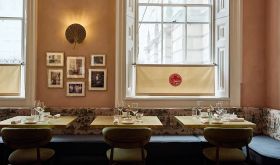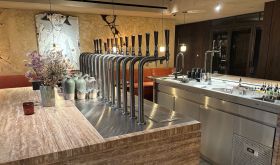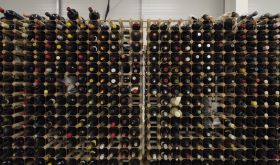Note: In order to deliver this article to you as early as possible, it has been translated with the use of AI. It has been added to a queue for a human translator to fully review and edit. Please pardon any minor translation imperfections while it is being reviewed.
东京是一座迷人的城市。其超过3700万的人口使其成为世界上最大的城市,它可能拥有与伦敦一样多种不同烹饪风格的餐厅。
法国对其烹饪风格的影响在过去50年中一直很明显,而年轻的日本厨师在巴黎的餐厅中崭露头角已有30年之久。我记得已故的让-克洛德·弗里纳 (Jean-Claude Vrinat)(当时是泰勒旺 (Taillevent) 的老板)和阿兰·杜卡斯 (Alain Ducasse) 之间的一次对话,他们都同意他们吃过的最好的法式长棍面包是在东京烘焙的。这种双向交流至今仍然非常强劲。
狂欢节 (Mardi Gras) 和青山酒窖门 (Cellar Door Aoyama) 是分别位于银座和港区的两家非正式餐厅。每家都有强烈的法式影响,尽管两位厨师都是日本出生的。两家都不在一楼——这就是东京餐饮业昂贵租金的压力——两家都是其创始人激情的非常个人化的表达。在狂欢节,这是厨师/老板的烹饪抱负。在青山酒窖门沙龙 (The Salon @ Cellar Door Aoyama) 的情况下,这是出生于伯肯黑德 (Birkenhead) 的老板卡尔·罗宾逊 (Carl Robinson) 和他的妻子珍妮特 (Jeanette) 对葡萄酒的热情。
我花了一段时间才找到狂欢节的入口,尽管我在正确的街道上,谷歌地图告诉我就在外面。唯一的线索是一个显示字母MG的低调标志,但即使如此,入口也不明显,直到我的眼睛发现了一组向下的台阶。多么一组台阶啊!
陡峭,由混凝土制成,对于任何超过六英尺的人来说都不容易攀爬,这些对任何顾客来说都是相当大的障碍。我不羡慕我看到的那个送几箱葡萄酒的送货司机。
但请坚持下去。这是一位敬业厨师和智彻 (Toru Wachi)(下图)的餐厅,他至少有两大激情:法式烹饪,特别是红肉,尽管他在糕点方面也很有一手,还有蓝调音乐。餐厅的名字来源于和智对北美深南部音乐的热爱。
一旦你下去了,你就进入了一个即使在这个拥挤的城市中也非常特别的空间。在狭窄房间的一端,刚好够放两张桌子,最多能坐22人,是和智音乐和其他许多东西的来源,他称之为他的"沙龙"。另一端是厨房,足够和智和他的一个助手使用。在展示的厨房必需品中,有一样东西立即吸引了我的眼球。
这个在柜台上的,显然是今天上午工作的成果。这是一个新鲜制作的挞,明亮的黄色水果被切成两半,闪闪发光,暴露在外。我表达了我的赞赏,这种做法得到了一连串的微笑和鞠躬,和智解释说这些是金桔,我的《日本食物词典》将其翻译为金桔。
我们与几位日本酿酒师、葡萄酒作家和教育工作者坐下来,我们的午餐——在周六,我一周中最喜欢的一餐——开始了。虽然第一道混合开胃菜显示了厨房的灵巧,但主菜显示了厨房的心真正所在。
和智的助手突然出现在我的肩膀旁。他手里拿着一个托盘,上面放着一大块牛肉,他自豪地展示后回到厨房。然后牛肉被送给我们所有人,作为一大块厚片,旁边是一些美味的小土豆,用大蒜瓣炒得酥脆。肉非常出色,味道浓郁,需要一定程度的咀嚼才能释放出所有的魅力。
挞的酥皮非常出色。午餐后,和智友好地提供了食谱(我在页面底部分享了)以及几个问题的答案。首先,他的位置在过去30年中一直是一家餐厅。其次,当我问他关于楼梯的陡峭时,他回答说他们在寻找"身体强壮"的顾客。至于找到他的餐厅,他回答说,"只要从银座站给我打电话,我会来接你。"
找到青山酒窖门的入口也是一个挑战。像我们在日本去的所有餐厅一样,它在一条小街上。但当我们被城市地图引导到一栋现代建筑时,入口是在右边还是左边?真的在楼上吗?我们爬上楼梯,记住在亚洲很多零售店不在一楼,进入了对任何葡萄酒爱好者来说都必须是阿拉丁洞穴的地方(见上面的主图)。
这家店承载着卡尔和珍妮特·罗宾逊 (Carl and Jeanette Robinson) 的葡萄酒进口业务耶罗波安 (Jeroboam) 过去30年的成果。他们都出生在利物浦,但在新西兰相遇,他们的父母在1950年代末作为十英镑移民移居那里。然后他跟随她到日本,他们在那里定居并开始从事葡萄酒业务,最初得到宝禄爵 (Pol Roger)、雨果 (Hugel) 和佩兰家族(博卡斯特尔酒庄 (Château de Beaucastel) 的所有者)的支持,现在与他们合作。
专门用于葡萄酒的大房间里吸引人地摆满了罗宾逊夫妇直接从全球葡萄酒家族进口的葡萄酒。富有的日本、中国和韩国葡萄酒爱好者来这里购买他们的柏图斯 (Petrus) 酒瓶,相信这里葡萄酒的真实性。
通过一扇双门,你面对几张长桌,可以坐24人,你可以从商店带任何一瓶酒到这里,没有任何额外的加价。"我们在这里开业的唯一目的是促进商店的销售,"罗宾逊以令人钦佩的诚实承认。
食物来自一个狭小、拥挤的厨房,但来自一个明显有才华的小团队,由厨师绪方 (Ogata)(上图与罗宾逊一起)领导,他在已故的贝尔纳·卢瓦索 (Bernard Loiseau) 在法国的餐厅接受培训,非常令人印象深刻。乡村肉酱被作为一厚片多汁的肉提供;下面的萤火虫鱿鱼盘非常应季。
与我们主菜一起的炒竹笋是另一个春季特色,用马肉制作的辣味鞑靼牛排调味得很好。最好的是法式小牛腰肉烤制,配羊肚菌和蚕豆以及下面的奶油蘑菇酱,让我想知道我们是在巴黎还是东京。
我们喝的葡萄酒决定了答案。我们从米尼翁·布拉德 (Mignon Boulard) 香槟开始,然后品尝了韦尔海姆博士 (Dr Wehrheim) 的2022年曼德尔贝格白皮诺 (Mandelberg Weissburgunder),卢克特 (Luckert) 的弗兰肯西万尼 (Franken Silvaner) 和一瓶稀有的新西兰贝尔山霞多丽 (Bell Hill Chardonnay) 2019,最后以来自原始雅梅 (Jamet) 的2012年罗第丘 (Côte Rôtie) 珍品结束。我们在巴黎不会受到如此丰富的款待。
那天晚上我们睡得异常好。
狂欢节 (Mardi Gras) 东京都中央区银座8丁目6-19号,邮编104-0061;电话:+81 (0)3-5568 0222
青山酒窖门 (Cellar Door Aoyama) 东京都港区南青山2丁目27-18号青山通道2楼,邮编107-0062;电话:+81 3 6804 5200
金桔挞
甜酥皮
足够制作五个直径18厘米的模具
黄油200克
蛋糕粉500克
糖150克
鸡蛋1个
蛋黄2个
在处理器中粗略混合所有成分。保持碎屑状态。分成几份并储存在冷冻室中。解冻后根据需要使用。
杏仁奶油
黄油200克
糖粉200克
鸡蛋4个
杏仁粉225克 将黄油恢复到室温。加入糖粉并混合至结合。逐渐加入蛋黄并充分混合。分几次混入杏仁粉。
制作挞
将面团压入挞模中。在冰箱中冷藏30分钟。从冰箱中取出,用叉子在酥皮上戳洞。将杏仁奶油挤入模具中。在顶部排列10-15个切成两半的金桔。在150°C烤箱中烘烤1-1.5小时。冷却后食用。
食谱由东京狂欢节厨师和智彻 (Toru Wachi) 提供。
顶部青山酒窖门照片,由餐厅/酒类商店提供。

